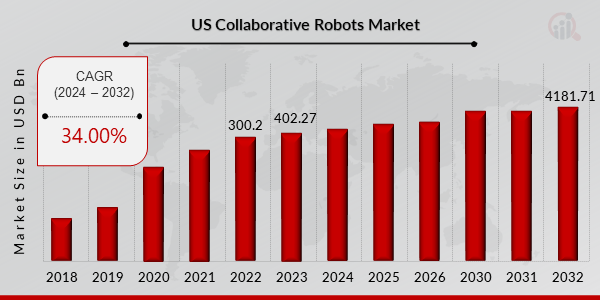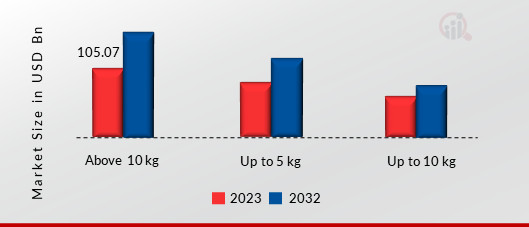United States Collaborative Robot Market Overview
US Collaborative Robot Market Size was valued at USD 300.2 Billion in 2022. The collaborative robot market industry is projected to grow from USD 402.27 Billion in 2023 to USD 4181.71 Billion by 2032, exhibiting a compound annual growth rate (CAGR) of 34.00% during the forecast period (2024 - 2032). Advancements in artificial intelligence and machine learning technologies and increased demand for automation in manufacturing are the main market drivers anticipated to propel the collaborative robot market in the United States.

Source: Secondary Research, Primary Research, MRFR Database and Analyst Review
Collaborative Robot Market Trends
-
Growing focus on human-robot collaboration is driving the market growth
The United States collaborative robot industry is expanding rapidly due to the growing emphasis on human-robot collaboration across industries. As businesses seek to increase efficiency, safety, and production, collaborative robots or cobots provide an attractive response. While typical industrial robots frequently require safety cages and function independently of humans, cobots are meant to work alongside human workers in a shared office. Sensor technology and artificial intelligence developments enable cobots to recognize and respond to human presence while ensuring safe interactions. With a market CAGR exceeding expectations, companies increasingly adopt collaborative robots to enhance productivity while ensuring safety. Sensor technology advancements, artificial intelligence, and flexible programming drive market growth. Furthermore, cost-effectiveness and regulatory compliance drive collaborative robot adoption across various sectors, indicating their presence in modern workplaces. Companies also recognize collaborative robots are more cost-effective than traditional automation systems as they require less infrastructure and can be rapidly installed and modified to meet changing production demands.
Furthermore, the collaborative robot market is experiencing rapid growth due to the flexibility and adaptability of these robots across various industries. Unlike traditional industrial robots, collaborative robots are designed to work with humans without safety barriers, enabling seamless integration into diverse work environments. This adaptability is particularly desirable in manufacturing, automotive, electronics, healthcare, and logistics industries, where activities might change significantly and require constant restructuring. The United States market is also growing due to continued advances in collaborative robot technology, which include better sensors, higher AI capabilities, and easy programming interfaces that allow for rapid deployment and reconfiguration. The emphasis on workplace safety and ergonomics further drives the adoption of collaborative robots, as they mitigate risks associated with repetitive tasks and heavy lifting, thereby reducing the likelihood of injuries and enhancing employee well-being. For instance, at CES 2024, Doosan Robotics Inc., a renowned collaborative robot (cobot) manufacturer, revolutionized the robotics industry by unveiling cutting-edge cobots and AI technologies, all under a cohesive theme. As industries seek to optimize processes and respond to dynamic market demands, the agility of cobots becomes increasingly invaluable, driving the collaborative robot market revenue.
Collaborative Robot Market Segment Insights
Collaborative Robot Payload Capacity Insights
The US Collaborative Robot Market segmentation, based on payload capacity, includes Up to 5kg, Up to 10kg, and Above 10kg. The above 10kg segment dominated the market mostly, holding a 35% share. These heavier robots cater to industries with demanding applications such as manufacturing, logistics, and automotive assembly. Companies are developing innovative technologies to address this market, enhancing payload capacities, precision, and safety features. As the largest segment within the collaborative robotic market, solutions targeting payloads above 10kg are pivotal in driving productivity and efficiency across various industries, shaping the future of automation.
Figure 1: US Collaborative Robot Market, by Payload Capacity, 2023 & 2032 (USD Billion)

Source: Secondary Research, Primary Research, MRFR Database and Analyst Review
Collaborative Robot Application Insights
The US Collaborative Robot Market segmentation, based on application, includes assembly, pick & place, handling, packaging, quality testing, machine tending, gluing & welding, and others. The pick & place category generated the most income. Its versatile applications across industries, including manufacturing, logistics, and e-commerce, drive this dominance. Pick-and-place robots streamline repetitive tasks by efficiently handling the sorting, transferring, and placing items, enhancing productivity while ensuring safety in collaborative environments. With technological advancements, these robots offer increased precision, adaptability, and ease of integration, further solidifying their pivotal role in modern automation ecosystems.
Collaborative Robot Vertical Insights
The US Collaborative Robot Market segmentation, based on vertical, includes automotive, food & beverage, furniture & equipment, plastic & polymers, metal & machinery, electronics, pharma, and others. The automotive category generated the most income. Industrial collaborative robots are increasingly integrated into automotive manufacturing processes, offering efficiency and safety enhancements. Their ability to work alongside human operators seamlessly has made them essential in tasks such as assembly, material handling, and quality control. This trend highlights the critical role of collaborative robots in optimizing production workflows and meeting the evolving needs of the automotive industry's modernization drive.
Collaborative Robot Country Insights
The collaborative robotic market in the United States has witnessed substantial growth in recent years, driven by factors such as increasing demand for automation across industries, advancements in robotic technologies, and a focus on improving workplace safety. Collaborative robots in the United States are designed to work alongside humans, enhancing productivity and efficiency in tasks ranging from manufacturing and logistics to healthcare and agriculture. With their user-friendly interfaces and flexibility, cobots offer a cost-effective solution for businesses looking to streamline operations and adapt to changing market demands. Key players in the United States Collaborative robotic market include Universal Robots, ABB, Fanuc Corporation, and Yaskawa Electric Corporation. As the adoption of cobots continues to expand, the market is projected to experience further growth, driven by ongoing technological innovations and the need for agile and adaptable automation solutions.
Collaborative Robot Key Market Players & Competitive Insights
Leading market players are investing heavily in research and development to expand their product lines, which will help the Collaborative Robot market grow even more. Market participants are also undertaking various strategic activities to expand their footprint, with important market developments including new product launches, contractual agreements, mergers and acquisitions, higher investments, and collaboration with other organizations. To expand in a more competitive and rising market climate, the collaborative robot industry must offer cost-effective items.
Major players in the collaborative robot market are attempting to increase market demand by investing in research and development operations includes ABB Group, DENSO Robotics, Epson Robots, Energid Technologies Corporation, F&P Robotics AG, Fanuc Corporation, KUKA AG, MRK-Systeme GmbH, Precise Automation, Inc., Rethink Robotics, Inc., Robert Bosch GmbH, Universal Robots A/S, Yaskawa Electric Corporation, MABI Robotic AG, Techman Robot Inc., Franks Emika Gmbh, AUBO Robotics, Comau S.p.A.
Key Companies in the Collaborative Robot market include
- ABB Group
- DENSO Robotics
- Epson Robots
- Energid Technologies Corporation
- F&P Robotics AG
- Fanuc Corporation
- KUKA AG
- MRK-Systeme GmbH
- Precise Automation, Inc
- Rethink Robotics, Inc
- Robert Bosch GmbH
- Universal Robots A/S
- Yaskawa Electric Corporation
- MABI Robotic AG
- Techman Robot Inc.
- Franks Emika Gmbh
- AUBO Robotics
- Comau S.p.A.
Collaborative Robot Industry Developments
February 2024: The Massachusetts Technology Collaborative (MassTech) initiated a $5 million-funded effort to enhance the robotics sector statewide. They established a new department within the Innovation Institute at MassTech to drive comprehensive cluster development, focusing on R&D, testing, commercialization, and workforce development.
October 2023: Amazon unveiled two new robotic initiatives to aid employees and improve customer service. Sequoia, a new robotic system, was launched to assist with holiday order fulfillment at a fulfillment center in Houston, Texas. Additionally, Amazon began testing Agility Robotics' bipedal robot, Digit, for potential use in warehouse operations, showcasing its ability to move and handle items efficiently in confined spaces.
Collaborative Robot Market Segmentation:
Collaborative Robot Payload Capacity Outlook
- Up to 5kg
- Up to 10kg
- Above 10kg
Collaborative Robot Application Outlook
- Assembly
- Pick & Place
- Handling
- Packaging
- Quality Testing
- Machine Tending
- Gluing & Welding
- Others
Collaborative Robot Vertical Outlook
- Automotive
- Food & Beverage
- Furniture & Equipment
- Plastic & Polymers
- Metal & Machinery
- Electronics
- Pharma
- Others
|
Report Attribute/Metric
|
Details
|
|
Market Size 2022
|
USD 300.2 Billion
|
|
Market Size 2023
|
USD 402.27 Billion
|
|
Market Size 2032
|
USD 4181.71 Billion
|
|
Compound Annual Growth Rate (CAGR)
|
34.00% (2024-2032)
|
|
Base Year
|
2023
|
|
Market Forecast Period
|
2024-2032
|
|
Historical Data
|
2019-2022
|
|
Market Forecast Units
|
Value (USD Billion)
|
|
Report Coverage
|
Revenue Forecast, Market Competitive Landscape, Growth Factors, and Trends
|
|
Segments Covered
|
Payload Capacity, Application, Vertical, and Region
|
|
Countries Covered
|
United States
|
|
Key Companies Profiled
|
ABB Group, DENSO Robotics, Epson Robots, Energid Technologies Corporation, F&P Robotics AG, Fanuc Corporation, KUKA AG, MRK-Systeme GmbH, Precise Automation, Inc., Rethink Robotics, Inc., Robert Bosch GmbH, Universal Robots A/S, Yaskawa Electric Corporation, MABI Robotic AG, Techman Robot Inc., Franks Emika Gmbh, AUBO Robotics, Comau S.p.A.
|
|
Key Market Opportunities
|
· Cost-effective solutions for streamlining operations and adapting to market demands.
· Facilitating remote monitoring and control of cobots, enhancing access and flexibility.
|
|
Key Market Dynamics
|
· Increased demand for automation in manufacturing.
· Flexibility and adaptability of collaborative robots in various industries.
|
Frequently Asked Questions (FAQ) :
The US Collaborative Robot Market size was valued at USD 300.20 Billion in 2023.
The market is projected to grow at a CAGR of 34.00% during the forecast period, 2024-2032.
The key players in the market are ABB Group, DENSO Robotics, Epson Robots, Energid Technologies Corporation, F&P Robotics AG, Fanuc Corporation, KUKA AG, MRK-Systeme GmbH, Precise Automation, Inc., Rethink Robotics, Inc., Robert Bosch GmbH, Universal Robots A/S, Yaskawa Electric Corporation, MABI Robotic AG, Techman Robot Inc., Franks Emika Gmbh, AUBO Robotics, Comau S.p.A.
The above 10kg category dominated the market in 2023.
The automotive category had the largest share of the market.




























